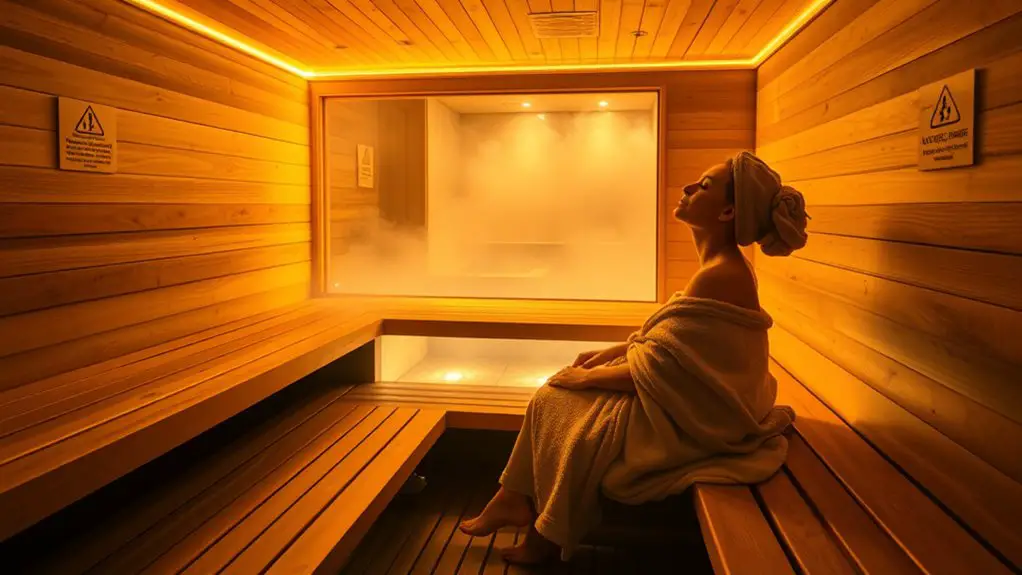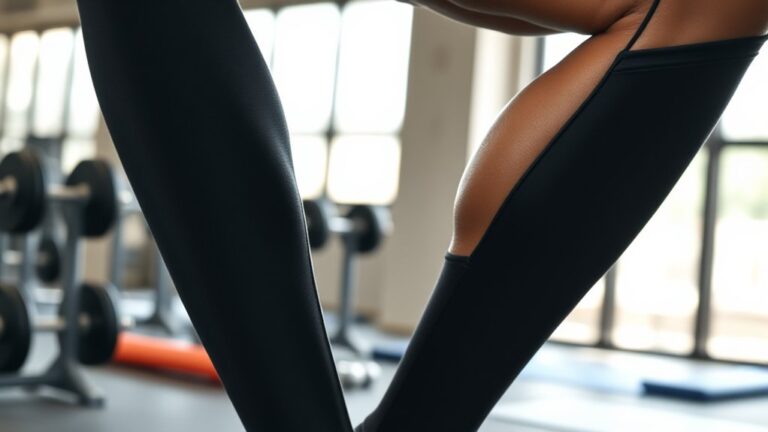How to Use Sauna and Steam Rooms for Recovery

To use saunas and steam rooms for recovery, hydrate before and after sessions to stay refreshed. Aim for 15-20 minutes in a sauna at 150°F to 195°F or a steam room at 110°F to 120°F to boost circulation and alleviate muscle soreness. Practice good hygiene by showering beforehand and consider incorporating sessions post-workout for best benefits. Pay attention to your body signals, and if you’re curious about more techniques and tips, there’s plenty to explore further.
Understanding the Benefits of Sauna and Steam Room Use

When you step into a sauna or steam room, you’re not just treating yourself to a moment of relaxation; you’re also tapping into a range of health benefits that can enhance your recovery process. Sauna benefits include improved circulation and detoxification, helping to flush out toxins from your body. As your heart rate increases, your blood flow enhances, delivering oxygen and nutrients to tired muscles, promoting faster recovery.
On the other hand, steam room advantages come from the humid environment, which can alleviate respiratory issues and hydrate your skin. The heat encourages your body to sweat, releasing impurities while simultaneously soothing sore muscles. Both spaces can reduce stress and promote overall well-being, creating a perfect environment for mental relaxation. Incorporating sauna and steam room sessions into your routine can greatly support your recovery journey, making them essential tools for anyone serious about their health.
How Heat Affects Muscle Recovery
When you expose your body to heat, it considerably boosts blood circulation, which helps deliver essential nutrients to your muscles. This increased blood flow not only aids in muscle relaxation but also promotes the elimination of toxins that can hinder recovery. Understanding these benefits can enhance your post-exercise routine and speed up your healing process.
Increased Blood Circulation
One of the key benefits of using sauna and steam rooms for recovery is the significant increase in blood circulation they promote. When you expose your body to heat, your blood vessels dilate, enhancing blood flow throughout your muscles. This increased circulation not only helps deliver oxygen and nutrients but also aids in flushing out metabolic waste, speeding up recovery. Improved blood flow can also support cardiovascular health, as it encourages your heart to pump more efficiently during and after your sauna session. By incorporating these heat therapies into your routine, you’re not just enhancing recovery but also taking proactive steps toward maintaining overall wellness. So, if you’re aiming for peak recovery, consider adding sauna and steam room sessions to your regimen.
Muscle Relaxation Benefits
Heat therapy offers remarkable muscle relaxation benefits that can greatly enhance recovery. When you expose your muscles to heat, it helps to alleviate muscle tension and improve flexibility. This relaxation technique increases blood flow, allowing oxygen and nutrients to reach tired muscles more efficiently. As your body warms up, it can help reduce stiffness, making it easier for you to move and engage in physical activity afterward. Additionally, the soothing effects of heat can trigger the release of endorphins, your body’s natural pain relievers. Incorporating sauna or steam room sessions into your recovery routine can be an effective way to help your muscles unwind and recover after intense workouts, promoting overall relaxation and well-being.
Toxin Elimination Process
There’s a common misconception that sweating alone is the key to detoxification, but the truth is that the process is more intricate. When you use sauna and steam rooms, heat stimulates your body’s detoxification methods, enhancing the elimination of toxins.
Your sweat composition plays an essential role, as it’s not just water; it also contains:
- Heavy metals like lead and mercury
- Lactic acid from muscle exertion
- Urea, a byproduct of protein metabolism
- Alcohol, which can linger post-consumption
- Salts and minerals that help maintain balance
Best Practices for Using a Sauna
While using a sauna can considerably enhance your recovery, following best practices guarantees you reap the maximum benefits safely. To start, always hydrate before and after your session; dehydration can counteract the positive effects. Aim for 15-20 minute sessions, allowing your body to acclimate gradually. After a workout, integrating sauna time into your post workout routine can aid muscle relaxation and reduce soreness.
Here’s a quick reference for effective sauna use:
| Best Practice | Recommendation |
|---|---|
| Hydration | Drink water before and after |
| Session Length | 15-20 minutes |
| Temperature Awareness | Listen to your body’s signals |
Remember sauna etiquette: wipe down your space, keep conversations quiet, and respect others’ relaxation time. By following these guidelines, you’ll optimize your sauna experience and aid your recovery process effectively.
Best Practices for Using a Steam Room

After enjoying the benefits of a sauna, you might want to explore how a steam room can further enhance your recovery. To make the most of your steam room experience, keep these best practices in mind:
- Arrive clean: Shower before entering to maintain hygiene.
- Mind your time: Limit your session to avoid overheating.
- Bring a towel: It’s a staple for comfort and steam room etiquette.
- Stay quiet: Respect others’ relaxation by keeping conversations low.
- Hydrate after: Replenish lost fluids with water or electrolyte drinks.
Following these guidelines can amplify the soothing effects of steam therapy. Remember, effective post session hydration is essential to aid recovery, so make sure you drink enough water after your steam room visit. By adhering to these practices, you’ll not only enhance your recovery but also contribute to a positive environment for everyone sharing the space.
Ideal Duration and Temperature Settings
To enhance your recovery in a steam room, it’s essential to find the right balance between duration and temperature. The ideal temperature for most steam rooms hovers around 110°F to 120°F (43°C to 49°C). This range promotes relaxation and muscle recovery without overwhelming your body.
For peak duration, aim for 15 to 20 minutes per session. This timeframe allows your body to reap the benefits of increased circulation and detoxification without risking overheating. If you’re new to steam rooms, start with shorter sessions, gradually working your way up to the peak duration as your body adjusts.
Listen to your body—if you start feeling dizzy or uncomfortable, it’s time to exit. Remember, consistency is key; incorporating regular steam sessions into your recovery routine can enhance overall wellness and performance.
Hydration: The Key to Effective Recovery

Spending time in a steam room can leave you feeling refreshed, but it’s important to remember that hydration plays an essential role in maximizing those recovery benefits. To maintain fluid balance and enhance your recovery, consider these hydration tips:
Hydration is key to enhancing recovery after a refreshing steam room session.
- Drink water before and after your session to replenish lost fluids.
- Opt for electrolyte-rich beverages to restore essential minerals.
- Monitor your urine color; a light yellow indicates good hydration.
- Snack on hydrating fruits like watermelon or oranges for extra moisture.
- Avoid alcohol and caffeine before your steam session, as they can lead to dehydration.
Combining Sauna and Steam Room Sessions
Combining sauna and steam room sessions can offer a powerful boost to your recovery routine. Each modality brings unique benefits that can enhance your overall wellness. Sauna benefits include improved circulation and muscle relaxation, which can help alleviate soreness after workouts. On the other hand, steam therapy is excellent for opening up airways and promoting respiratory health, making it a perfect complement to sauna heat.
Safety Considerations and Contraindications

Before you step into a sauna or steam room, it’s essential to take into account any underlying health conditions, as certain issues can make these environments unsafe for you. Additionally, sticking to recommended duration and temperature limits is key to avoiding overheating and dehydration. By being aware of these safety considerations, you can enjoy your recovery sessions with confidence.
Health Conditions to Avoid
While sauna and steam rooms can offer numerous benefits for recovery, it is crucial to recognize certain health conditions that might make their use risky. If you have any of the following medical conditions or skin sensitivities, you should consider avoiding these heat therapies:
- Cardiovascular issues: High blood pressure or heart disease can be aggravated by heat.
- Respiratory problems: Conditions like asthma may worsen in hot, humid environments.
- Skin conditions: Eczema or psoriasis could flare up due to heat and moisture.
- Pregnancy: Elevated body temperature can pose risks to both mother and baby.
- Recent surgeries: Healing wounds may be negatively impacted by excessive heat.
Always consult a healthcare professional before using sauna or steam rooms. Your safety is paramount!
Duration and Temperature Limits
Understanding the importance of duration and temperature limits is crucial for safe sauna and steam room use, especially after considering health conditions that might pose risks. For most individuals, duration recommendations suggest 15 to 20 minutes per session, allowing your body to acclimate without overexertion. Always listen to your body; if you start feeling dizzy or uncomfortable, it’s best to exit early.
As for temperature guidelines, saunas typically range from 150°F to 195°F (65°C to 90°C), while steam rooms are around 100°F to 120°F (38°C to 49°C). If you have cardiovascular issues or respiratory problems, consult a healthcare professional before use. Prioritizing these limits guarantees a safer, more enjoyable experience for recovery and relaxation.
Incorporating Sauna and Steam Rooms Into Your Routine
Incorporating sauna and steam rooms into your routine can be a game-changer for recovery, especially after intense workouts. These practices not only help alleviate muscle soreness but also offer a range of health benefits. To get the most out of your sessions, consider the following:
- Hydrate: Drink plenty of water before and after to replenish fluids.
- Timing: Aim for 15-20 minutes in the sauna or steam room, allowing your body to adjust.
- Sauna Etiquette: Always shower before entering and use a towel to sit on for hygiene.
- Mindfulness: Use this time to meditate or practice deep breathing, enhancing relaxation.
- Post-Workout Routine: Incorporate these sessions right after your workout for ideal muscle recovery and relaxation.
Frequently Asked Questions
Can I Use Sauna and Steam Rooms if I’m Pregnant?
Imagine stepping into a warm embrace, but when you’re pregnant, you need to tread carefully. Sauna safety’s essential; elevated body temperatures can pose risks. It’s best to consult your healthcare provider before using a sauna or steam room. If you do decide to go, keep steam room precautions in mind: limit your time and stay hydrated. Your comfort and health should always come first, so prioritize both for a safe experience.
How Often Should I Use a Sauna or Steam Room?
When it comes to using a sauna or steam room, frequency recommendations usually suggest 2 to 3 times per week for most people. Aim for an ideal duration of 15 to 20 minutes per session. This allows your body to reap the benefits without overdoing it. Always listen to your body, though, and adjust based on how you feel. Staying hydrated is essential, so don’t forget to drink plenty of water afterward!
Are There Any Specific Skin Benefits From Sauna or Steam Room Use?
Imagine stepping into a medieval bathhouse; you’re in for a treat! Using a sauna or steam room can do wonders for your skin. The heat opens up your pores, promoting skin hydration and enhancing detoxification effects. This not only helps to remove impurities but also leaves your skin looking fresh and rejuvenated. Regular use can improve circulation, giving you that healthy glow. So, why not indulge and reap those skin benefits?
Can I Use Sauna or Steam Rooms After a Workout?
Yes, you can definitely use saunas or steam rooms after a workout. They offer post workout benefits like muscle relaxation and improved circulation, which can enhance your recovery. However, keep hydration considerations in mind; sweating in these environments can lead to dehydration. Make sure you drink plenty of water before and after your session to stay properly hydrated. Enjoy the soothing heat, but listen to your body and don’t overdo it!
What Should I Wear in a Sauna or Steam Room?
Did you know that wearing appropriate attire in a sauna can enhance your experience? It’s best to wear minimal clothing, like a swimsuit or a towel, to promote comfort and hygiene. Sauna etiquette suggests avoiding heavy fabrics, as they can trap heat and moisture, making it uncomfortable. Always remember to respect others’ space and maintain cleanliness, ensuring a pleasant environment for everyone. So, keep it simple and enjoy your time!





